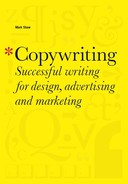Argos is the UK’s largest catalog retailer, enjoying more of the market share in jewelry, toys, and electrical beauty products than any other retailer. The company emerged from the Green Shield Stamp business, one of the original retail catalog businesses, and has a long history of innovation in this field. Copy has always been a core part of their approach, and their head of design, Sunita Yeomans, reveals their thinking and approach to writing.

to clarify and explain everything for our customers
Our strategy is to create a “world-class catalog with clear, detailed information to make choosing as easy as possible” and we are committed to jargon-free, benefits-led copy throughout our catalog. We initially addressed this through technology, and our IT systems helped us to discover that our catalog contained five ways to describe the same product feature of a TV. All of our suppliers were choosing to use a different set of words, and the Argos product descriptions were varying enormously.
The Approach:
get the best raw material and shape it for the reader
We commissioned a technology journalist to explain each of the products to us, and then asked copywriters to write benefit-led product descriptions and explanations. We created a system for charts that listed shared key features, and “Quick Guides” to explain some of these features. We then use more detailed “Argos Guides” to give full and detailed explanations of complex new technologies.
We use words to explain images and vice versa; they can complement each other and have to be considered together. Back in 1990, I wrote a degree dissertation titled “Words and images – with particular references to their role in communication.” I explored the ambiguity of images and icons, and how their meaning was greatly enhanced when combined with a few simple words. I’m still practicing this theory and I have had some really good results by using certain words to support our graphic icons.
One of the simplest examples of the power of words is the cover. I’ve been very surprised at the impact the words I’ve used have had – particularly as the picture is very similar to the last two covers. One of our big challenges at Argos is to explain our services quickly and easily. Compared to our current versions, previous icons were dull. They were line drawings with lots of text included underneath to explain them. They were a big improvement on the previous approaches we took, but we have greatly refined this technique now.
The latest set (on the spine and inside cover of the catalog) combines strong visual imagery with emotive and memorable words that relate back to the advertising campaign of “Don’t Shop for it, Argos it;” for example, “Check and Reserve it,” “Collect it. Choose it.”
The word “wow!” is used by many retailers to explain and highlight the best promotions or deals. We use it a lot, and recently commissioned copywriters to find a new word that Argos could own. However nothing was as memorable or visually simple as “wow!” so we decided to stick with it, but to change it to an “Argos WOW!” with an explanatory copy line of “our best deals” and a typographic execution that mimics the Argos logo to help make each one stand out in the catalog and in-store, and leverage the strength of the Argos brand.
The Result:
customers have a stronger sense of the Argos brand
The latest cover is the first one on which I’ve used words to explain the picture, and I’ve had a far greater spontaneous response, for example, “I love the front cover – it’s all about how the catalog is so full of products that it’s bursting with choice.” Customers look at the cover more – and get it – and so do the staff in stores and at head office.
In research, customers have noticed the icons, like them, and immediately know what they mean. We have used Argos on a number of features to help strengthen our brand, for example with the “Argos Quick Guides” and the “Argos WOW!s.” We’ve found that customers refer to our information panels as the “Argos Quick Guides” when they are simply called “Quick Guides.”
Google have pioneered the thinking that a logo is not sacred – they have shown that the strength of the brand is in the name, not the typography. I am currently investigating whether brand recognition is stronger when I use the logo, or just the word Argos.

